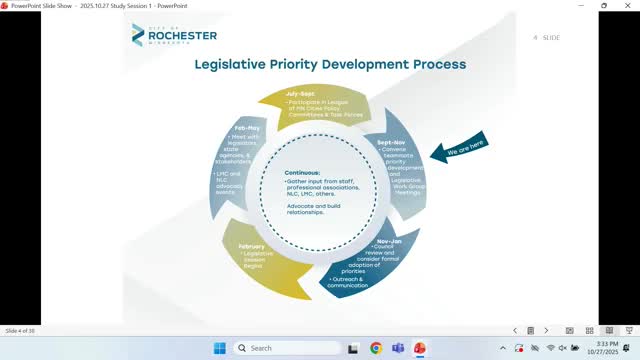Rochester reports first-year 3-1-1 results; council presses for clearer response standards
October 27, 2025 | Rochester, Olmsted County, Minnesota
This article was created by AI summarizing key points discussed. AI makes mistakes, so for full details and context, please refer to the video of the full meeting. Please report any errors so we can fix them. Report an error »

The city's Communications, Engagement and 3-1-1 division presented its first-year metrics on Oct. 27, reporting about 40,400 phone calls in the program's initial year and steady growth in self-service knowledge-base and chatbot interactions.
Jenna Bowman, strategic communications and engagement director, said the 3-1-1 service functions as a centralized intake to connect residents, businesses and visitors with city services while leaving department-level customer service (for example RPU and the library) intact. Bowman said the 3-1-1 team has three staff dedicated to phone intake and a hybrid model that embeds communications specialists in several departments.
Key figures and findings
Bowman said the program handled roughly 40,400 phone calls in the first year and currently averages about 188 calls per day; the team also added about 216 knowledge-base articles in the most recent six months and saw half of chatbot interactions occur in the last six months. A routing-intake form and staff adjustments have pushed routing accuracy toward about 99 percent.
Council follow-up requests and operational issues
Council members repeatedly pressed staff for clearer definitions and standards. Council member Palmer asked what portion of the daily calls are inspection-related; Bowman said inspection scheduling and related calls represent a substantial share of 3-1-1 volume. Multiple council members asked the division to report average response times for service requests, clarify the difference between general phone calls and formal service requests, and provide data explaining why some wards report substantially higher call volume than others.
"How are we marketing this to people?" Palmer asked, adding that many residents are unaware the service exists during business hours. Council members suggested additional promotion through city channels and partner outlets.
Voicemail handling, warm handoffs and response-time goals
Council members raised concerns about transferred calls that land in department voicemail boxes and about long open tickets for property- or code-related enforcement. Bowman acknowledged variable departmental processes and said additional staff capacity and internal coordination are intended to standardize handoffs and updates. Several council members advocated for a measurable acknowledgement timeframe ' for example, an initial contact within 24 to 48 hours to confirm a resident's report has been received and is being handled.
Communications, brand and trust
Bowman summarized the division's broader communications work ' including public information during emergencies, crisis communications, digital platforms, photography and a five-year brand program ' and council members urged a stronger emphasis on celebratory storytelling and tracking resident trust through periodic community surveys.
Provenance
The 3-1-1 and communications presentation begins at 40:54 in the transcript and the council discussion on response standards and marketing runs through the end of the session.
Jenna Bowman, strategic communications and engagement director, said the 3-1-1 service functions as a centralized intake to connect residents, businesses and visitors with city services while leaving department-level customer service (for example RPU and the library) intact. Bowman said the 3-1-1 team has three staff dedicated to phone intake and a hybrid model that embeds communications specialists in several departments.
Key figures and findings
Bowman said the program handled roughly 40,400 phone calls in the first year and currently averages about 188 calls per day; the team also added about 216 knowledge-base articles in the most recent six months and saw half of chatbot interactions occur in the last six months. A routing-intake form and staff adjustments have pushed routing accuracy toward about 99 percent.
Council follow-up requests and operational issues
Council members repeatedly pressed staff for clearer definitions and standards. Council member Palmer asked what portion of the daily calls are inspection-related; Bowman said inspection scheduling and related calls represent a substantial share of 3-1-1 volume. Multiple council members asked the division to report average response times for service requests, clarify the difference between general phone calls and formal service requests, and provide data explaining why some wards report substantially higher call volume than others.
"How are we marketing this to people?" Palmer asked, adding that many residents are unaware the service exists during business hours. Council members suggested additional promotion through city channels and partner outlets.
Voicemail handling, warm handoffs and response-time goals
Council members raised concerns about transferred calls that land in department voicemail boxes and about long open tickets for property- or code-related enforcement. Bowman acknowledged variable departmental processes and said additional staff capacity and internal coordination are intended to standardize handoffs and updates. Several council members advocated for a measurable acknowledgement timeframe ' for example, an initial contact within 24 to 48 hours to confirm a resident's report has been received and is being handled.
Communications, brand and trust
Bowman summarized the division's broader communications work ' including public information during emergencies, crisis communications, digital platforms, photography and a five-year brand program ' and council members urged a stronger emphasis on celebratory storytelling and tracking resident trust through periodic community surveys.
Provenance
The 3-1-1 and communications presentation begins at 40:54 in the transcript and the council discussion on response standards and marketing runs through the end of the session.
Don't Miss a Word: See the Full Meeting!
Go beyond summaries. Unlock every video, transcript, and key insight with a Founder Membership.
✓
Get instant access to full meeting videos
✓
Search and clip any phrase from complete transcripts
✓
Receive AI-powered summaries & custom alerts
✓
Enjoy lifetime, unrestricted access to government data
30-day money-back guarantee

